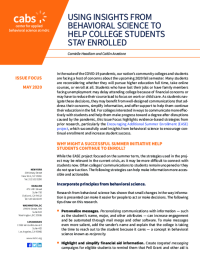Using Insights from Behavioral Science to Help College Students Stay Enrolled

In the wake of the COVID-19 pandemic, our nation’s community colleges and students are facing a host of concerns about the upcoming 2020 fall semester. Many students are reconsidering whether they will pursue higher education full time, take online courses, or enroll at all. Students who have lost their jobs or have family members facing unemployment may delay attending college because of financial concerns or may have to reduce their course load to focus on work or child care. As students navigate these decisions, they may benefit from well-designed communications that address their concerns, simplify information, and offer support to help them continue their education in the fall. For colleges interested in ways to communicate more effectively with students and help them make progress toward a degree after disruptions caused by the pandemic, this Issue Focus highlights evidence-based strategies from prior research, particularly the Encouraging Additional Summer Enrollment (EASE) project, which successfully used insights from behavioral science to encourage continual enrollment and increase student success.
Why might a successful summer initiative help students continue to enroll?
While the EASE project focused on the summer term, the strategies used in the project may be relevant in the current crisis, as it may be more difficult to connect with students now. Often colleges’ communications to students remain unopened or they do not spark action. The following strategies can help make information more accessible and actionable.
Incorporate principles from behavioral science.
Research from behavioral science has shown that small changes in the way information is presented can make it easier for people to act or make decisions. The following tips draw on this research.
- Personalize messages. Personalizing communications with information — such as the student’s name, major, and other attributes — can increase engagement and be automated through mail merge and other software. To make messages even more salient, add the sender’s name and explain that the college is taking the time to reach out to the student because it cares — a concept in behavioral science known as reciprocity.
- Highlight and simplify financial aid information. Create targeted messaging campaigns for eligible students to remind them that Pell Grant and other aid is available, along with registration information. To simplify financial aid information, inform students exactly how much federal and state grant funding they will receive for each level of enrollment (that is, 12+ credits, 9 to 11 credits, 6 to 8 credits, 1 to 5 credits). This strategy was implemented in the EASE project messaging campaign using a Summer Pell Grant calculator, developed by MDRC. A similar method could be employed for the fall, winter, and spring terms. Messages could also include additional financial information that may be important to student decision making this fall semester, such as the availability of emergency aid to overcome unexpected financial obstacles and reminders to eligible students that their Pell Grants may be large enough to fully cover their tuition costs. These strategies will provide students with a clearer picture of their financial aid, which may ease concerns and help students continue their education.
- Incorporate student testimonials. Consider sharing the perspectives of students’ peers. People often use the behavior of others to guide their own actions, so sharing the experiences of other students who are attending college in the fall can encourage others to do the same. Identify a few barriers to enrollment that students are facing, such as financial constraints, adjusting to online courses, and the ability to manage coursework; then, ask students who you know are enrolling this fall to share how they are coping with these challenges. Finding students who have completed online courses may be particularly relevant in this time. Incorporate these testimonials into different communications to help ease student concerns.
- Provide clear steps to enrollment and offer course suggestions. People are more likely to follow through on their goals if they make a plan for how they are going to achieve the action ahead of time. In addition, hassles in the process of selecting courses may be overwhelming, especially in this time of crisis. Share communications that include implementation prompts to guide students through enrollment steps, such as filing their financial aid applications. Include clear steps to help students not only register for but also select courses. For example, a message might direct students to review their degree plans, write down the courses they have not taken yet, and then immediately register for those courses. This process can be made even easier for students by providing direct hyperlinks to registration sites and offering three to five recommended courses. While this level of personalization can be more time consuming for college staff, it can take the burden off students and facilitate enrollment.
Create a targeted campaign of messages for select student groups.
Some college marketing campaigns focus mainly on new students rather than continuing students, who also need encouragement. Building on these insights, the EASE campaign identified a specific target group: Pell-eligible students enrolled in spring courses. To encourage fall enrollment, identify particular groups of students, such as those who are unregistered or eligible for Pell Grants, and send tailored messages to them. It is also important to send a campaign of communications as opposed to one or two messages. While receiving too many communications at once could overwhelm students, a coordinated campaign of messages will capture the attention of a larger group of students. Reminders are another powerful behavioral science tool for motivating action and may be particularly useful during stressful times, when students may be balancing even more competing priorities that usual.
Use multiple modes of communication.
Students report various communication preferences. While colleges rely largely on e-mail to connect with students, there is value in adding other modes of communication, particularly mailed letters. The findings from the EASE project showed that continuing students were more likely to recall physical letters in envelopes than other forms of communication. Colleges may also consider postings on learning management systems (such as Blackboard) and text messages. Using multiple methods to send similar messages can make it more likely that at least one of the modes will capture a student’s attention and help address equity concerns, such as lack of consistent access to the internet or stable housing.
Combine information from various departments.
Often students receive communications that focus only on a particular topic — say, financial aid or registration. However, it may be useful to create a messaging campaign that includes information from multiple departments. For example, the same message could share reasons to take courses this fall, remind eligible students that financial aid is available, and encourage students to meet with an adviser. If available, messages could also inform eligible students that they can apply for emergency aid if they are facing a financial barrier as a result of the pandemic.
Offer and communicate last-dollar tuition assistance to students from low-income families.
In addition to the communication strategies described above, research from EASE highlights another powerful strategy to help students remain enrolled: last-dollar tuition assistance. For some students, not having resources to pay for college courses will be a main hurdle to enrolling. This lack of sufficient resources may be exacerbated during the pandemic. Providing low-income students with last-dollar tuition assistance — which covers the difference between students’ tuition and fees and their grant financial aid (such as Pell Grant funding) — can significantly increase enrollment at a low cost. Any grants or other financial support should be communicated through a well-designed messaging campaign, so students are aware of the available funding. In the EASE project, students who received last-dollar tuition assistance in addition to a messaging campaign that encouraged them to make use of this additional aid were much more likely to enroll. As colleges look for ways to allocate limited resources, providing last-dollar tuition grants combined with the above messaging strategies is a proven way to boost enrollment and help students financially.[1]
Helpful resources
EASE Handbook for Community Colleges. MDRC’s guide to implementing the strategies used to increase enrollment in the EASE project. The guide includes message templates that colleges can use and adapt for their own campaigns as well as tips and other tools.
Behavioral Buzz: Five Evidence-Based Behavioral Science Practices for Social Services Agencies During COVID-19. This post provides behavioral science strategies that can be used to reduce the burdens for staff and service recipients.
Acknowledgments
MDRC would like to thank the Ascendium Education Group for generously funding the EASE project. We would also like to thank the administrators and staff at the community colleges in Ohio who participated in the research study, the Ohio Association of Community Colleges for their partnership and support, and our MDRC research team.
For additional information or help implementing the communication strategies described here, contact Camielle Headlam at Camielle.Headlam@mdrc.org or Caitlin Anzelone at Caitlin.Anzelone@mdrc.org.
[1] Camielle Headlam, Caitlin Anzelone, and Michael J. Weiss, Making Summer Pay Off: Using Behavioral Science to Encourage Postsecondary Summer Enrollment (New York: MDRC, 2018).






